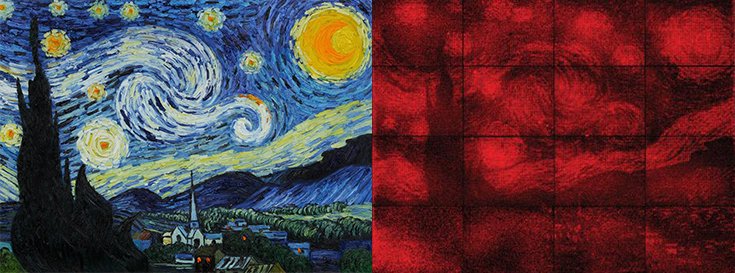Scientists Recreate a Microscopic Starry Night by Folding DNA
Scientists Recreate a Microscopic Starry Night by Folding DNA
Researchers at the California Institute of Technology have recreated Van Gogh’s iconic Starry Night painting in order to test methods of folding DNA and attaching fluorescent molecules.
Van Gogh’s iconic Starry Night painting in order to test methods of folding DNA and attaching fluorescent molecules. This is a practice that is often done on small computer chips. The monochromatic painting is about the width of a dime.
The CalTech scientists (and evidently artists), released their findings in the journal Nature . They call what they have done “DNA origami,” because it requires precisely folding genetic material. The precision folding is done to install fluorescent molecules into microscopic light sources called photonic crystal cavities (PCC). The bright atoms become dimmer every nanometer they are placed away from the PCCs, making it necessary for the scientists creating the art to use very precise folding techniques.Paul Rothemund, the professor who created the technique, stated:
Think of it a bit like the pegboards people use to organize tools in their garages, only in this case, the pegboard assembles itself from DNA strands and the tools likewise find their own positions. It all happens in a test tube without human intervention, which is important because all of the parts are too small to manipulate efficiently, and we want to make billions of devices.”
Now, the teams are working to improve the lifespan of the fluorescent molecules. At present, they only stay lit for about 45 seconds before flaming out due to a reaction with the oxygen in the air. They are also looking for a way to get them to emit only a shade of red, as at the moment, they release many different colors. This particular piece was set to a wavelength of 660 nanometers, which is why it emitted the red color.
“Depending on the exact size and spacing of the holes, a particular wavelength of light reflects off the edge of the cavity and gets trapped inside.
…. A fluorescent molecule tuned to the same color as a PCC actually glows more brightly inside the cavity, but the strength of this coupling effect depends strongly on the molecule’s position within the cavity. A few tens of nanometers is the difference between the molecule glowing brightly, or not at all …”
Rothemund also said that the process of DNA origami was like, “using DNA origami to screw molecular light bulbs into microscopic lamps.”
“… All previous work coupling light emitters to PCCs only successfully created a handful of working lamps, owing to the extraordinary difficulty of reproducibly controlling the number and position of emitters in a cavity,” Gopinath says.
The artistic representation of the DNA origami is a culmination of 10 years of refining the process to get it just right.
This new technology will be used in things like optical computer systems. In this sort of technology, many tiny light sources are needed to sit on a single chip.
| About Anna Scanlon: | |
| Anna Scanlon is an author of YA and historical fiction and a PhD student at the University of Leicester where she is finishing her degree in modern history. You can find out more about Anna and her books on her lifestyle blog annainwonderland.co.uk. | |
Other Popular Stories:
There are no related stories quite yet.

Post a Comment